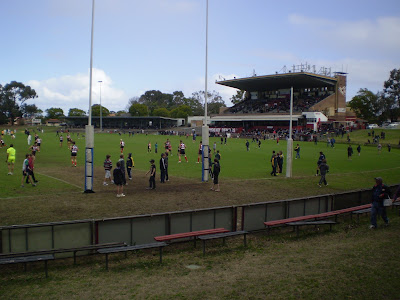ARTICLE: The name Pat Fogarty barely resonates in WA football circles now but it is doubtful that West Coast Eagles would be preparing to move to Lathlain Park next year without the Perth secretary’s foresight more than half a century ago.
Perth were based at the WACA Ground for most of their first 60 years but Fogarty, who was secretary for nearly 20 years before having two stints as president, was long convinced the club would only thrive by moving into the heart of its growing district.
It was a strategy later replicated with great success by West Perth in their shift to Joondalup but a move that attracted significant opposition from Perth supporters in the tough years after World War II.
But Fogarty was adamant — Perth had to move or perish.
He had identified the rudimentary ground at Goddard Street, the geographic centre of a new housing development, as the ideal site for the club and spent much of energies convincing the Perth city council of the value of his vision.
Merely delighted when Perth ended a 48-year premiership drought by winning the 1955 grand final, Fogarty was fulfilled four years later when the club moved to Lathlain Park and took possession of the magnificent grandstand fully funded by the council and named after then president EW Jones, a prominent Perth dentist hence his nickname “Brusher”, and himself.
It meant the club could now have their own liquor licence, a significant financial development given their tenancy at the WACA meant they kept little of the bar takings, a fact noted by the cricket association in 1955 when it congratulated Perth on their flag but regretted their imminent departure. The move to Lathlain could barely have been more successful.
Lathlain, Carlisle and surrounding suburbs were developing rapidly and under the energetic management of colts coach Jack Ensor, who would assemble and organise some of the greatest talent in the State’s history as part of his six premierships in seven seasons, Perth would soon enter the most glorious period of their existence.
The tough and inspirational Mal Atwell was convinced to leave East Perth to coach the club, outstanding players Barry Cable, Bob Shields, Greg Brehaut and Frank Pyke emerged as stars, and Perth became a WAFL powerhouse.
 A hat-trick of flags was delivered from 1966 to 1968, with Cable living up to his big game reputation by winning the Simpson Medal in each grand final, while the individual honours flowed on Sandover Medal night with Cable (three times), Neville Beard, Pat Dalton, Ian Miller and Bryan Cousins saluting within two decades of the move to Lathlain.
A hat-trick of flags was delivered from 1966 to 1968, with Cable living up to his big game reputation by winning the Simpson Medal in each grand final, while the individual honours flowed on Sandover Medal night with Cable (three times), Neville Beard, Pat Dalton, Ian Miller and Bryan Cousins saluting within two decades of the move to Lathlain.
The 1970s were barely less successful, with consecutive flags in 1976-77 and a heart-breaking two-point loss a year later, but the golden age was coming to an end.
The relationship with the council soured to the extent that Perth returned to the WACA for two seasons in the mid-1980s but the move didn’t work and was soon abandoned.
The Demons have been back at Lathlain for the past three decades with their current 20-year absence from finals the longest in WAFL history, but hopeful that Pat Fogarty’s foresight and the imminent arrival of the Eagles may foreshadow another golden era.
[By John Townsend for The West Australian. This article was first published at the following link: https://thewest.com.au/news/perth/demons-found-success-in-fresh-fields-ng-b88604804z]
 |
| The ground opening of Lathlain Park in 1959. |
 |
| Claremont are 99-points behind Perth in the final quarter of this July 1965 match. |
 |
| Mal Brown marks for East Perth at the back of Bob Shields while Barry Cable looks on. |
 |
| All the colour Lathlain Park pictures were taken by Kieran James at Perth versus Swan Districts, 2 July 2011. |
 |
| The old Victoria Park station (since demolished) in April 2005. The new station is 230 metres to the south of the old station making it very close to where the former Lathlain station was located. |












































